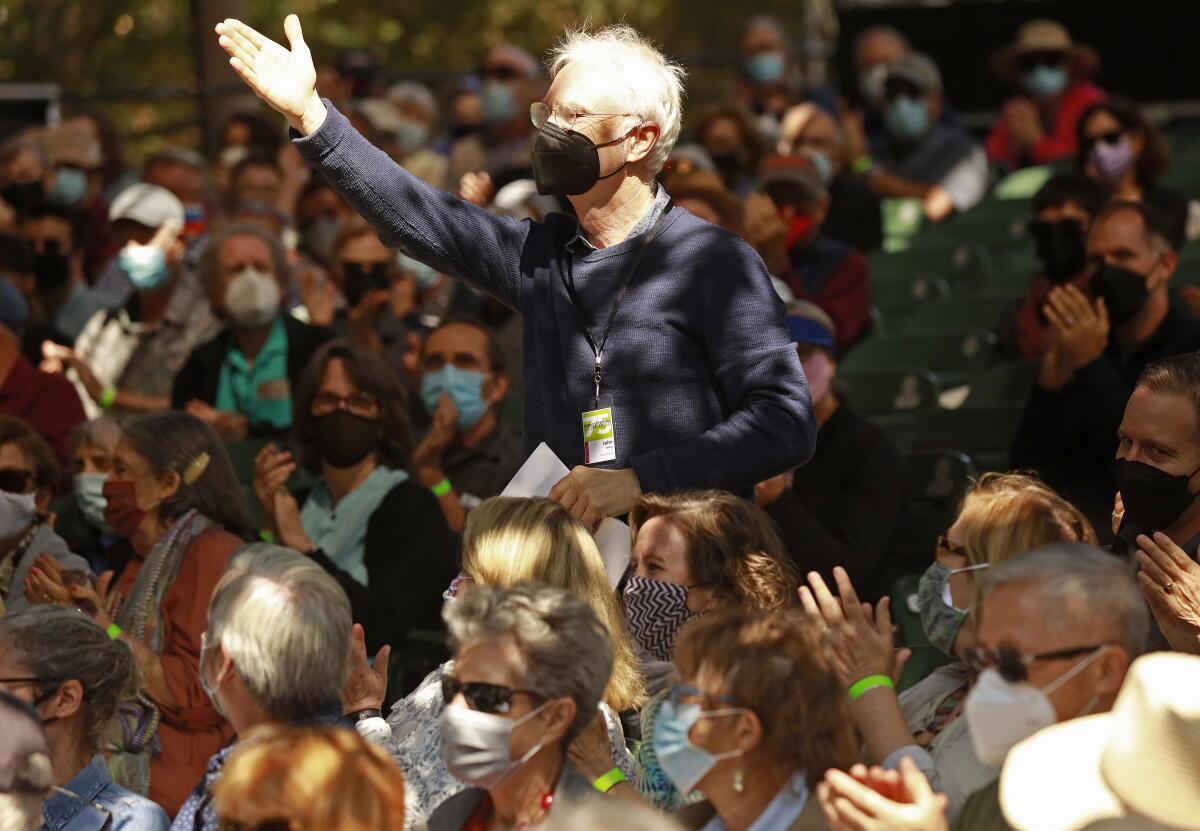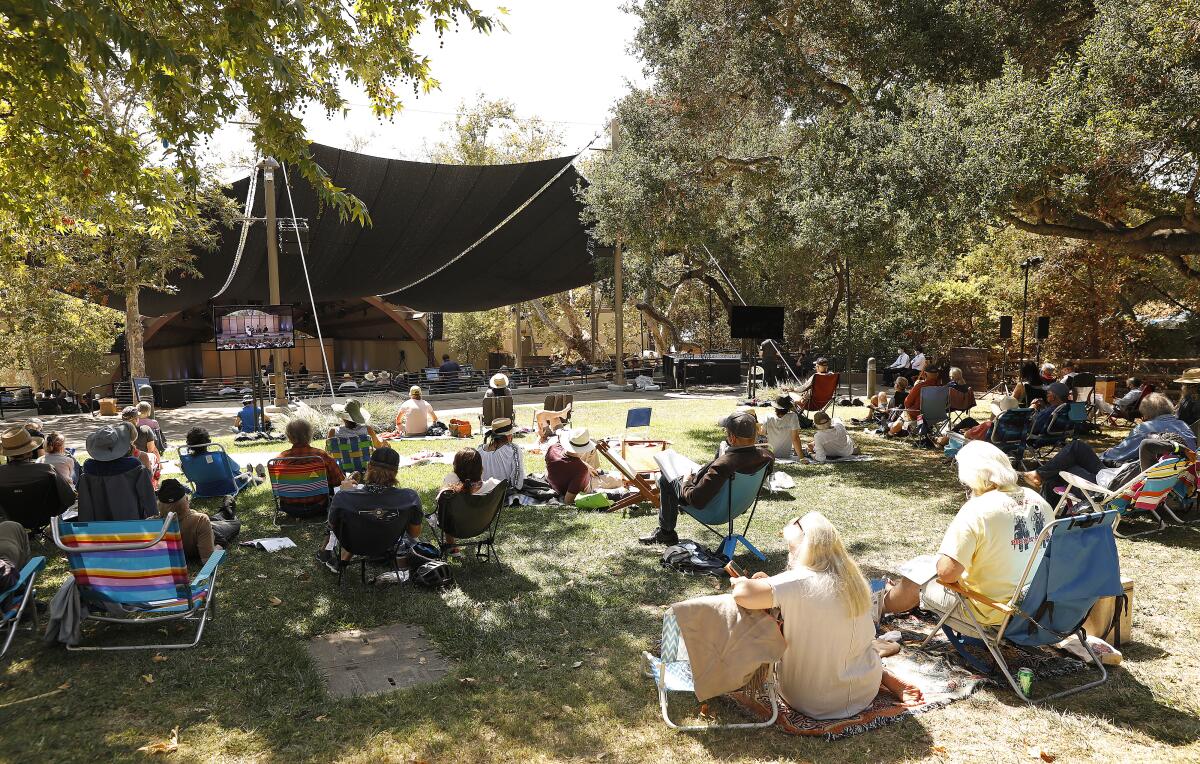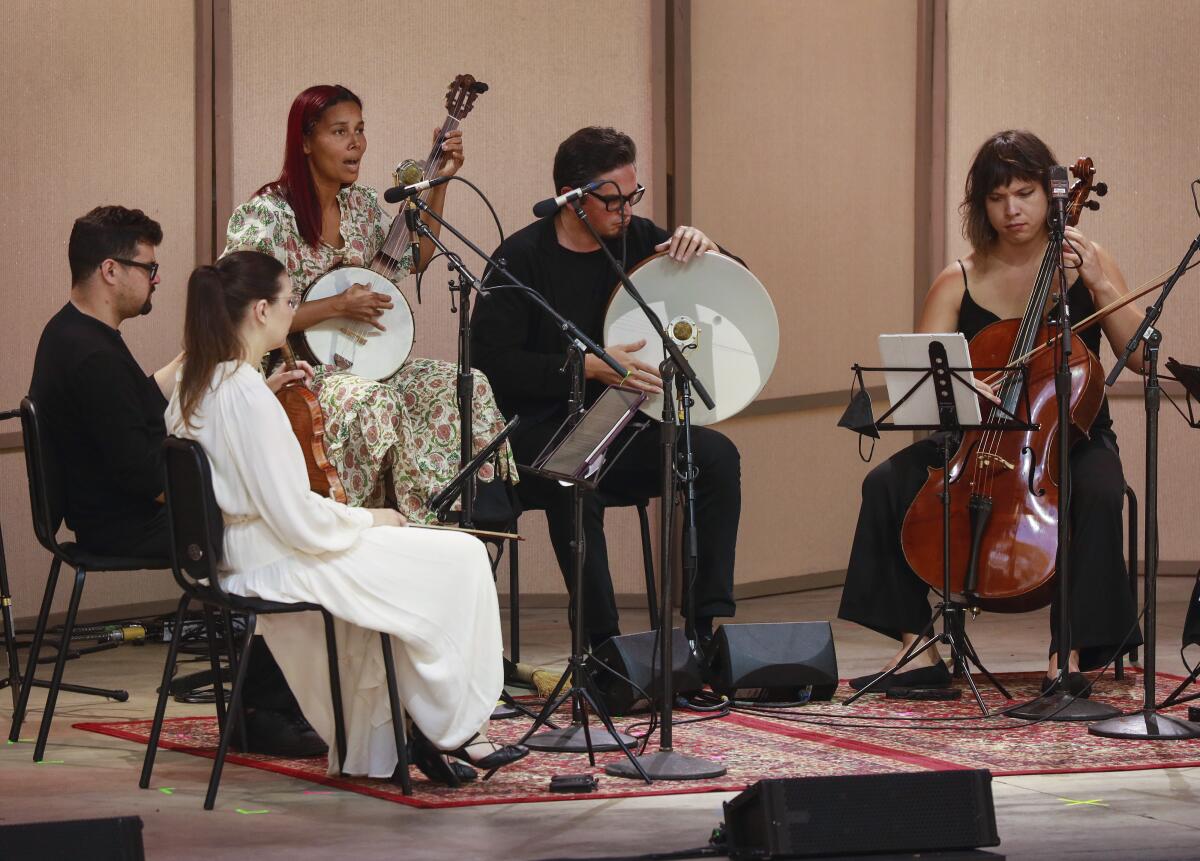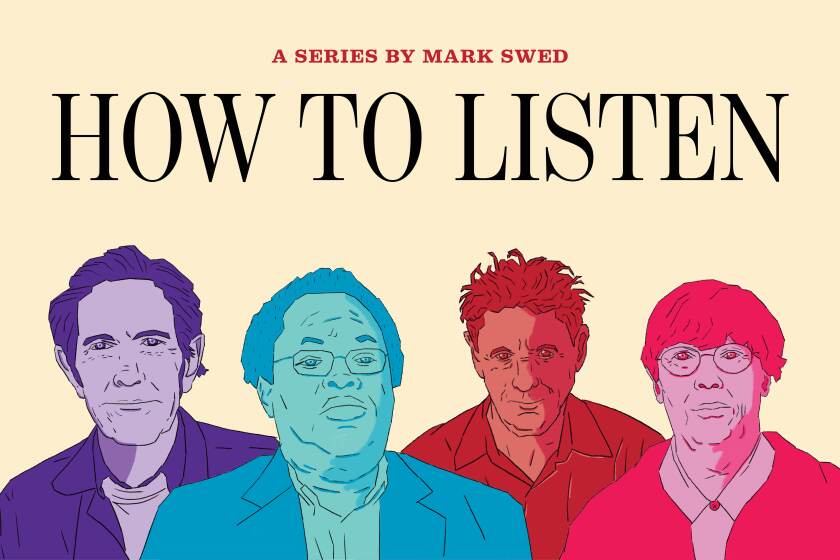Review: Ojai Music Festival begins a new era with exciting emerging talent

- Share via
Here’s what was lost by moving the Ojai Music Festival from the second weekend in June to the third in September: The damn Delta variant stole a potential pink moment that might have lent a uniquely Ojai ending to the festival. The late-afternoon Sunday finale, always the most attended concert of the festival, ended just after 7, and the sun already had set.
But here’s what was gained: everything else that has made the Ojai festival beloved for a full three-quarters of a century.
Against unsettlingly uncertain odds, Ojai’s 75th anniversary festival happened as hoped and promised, and it was special. Ojai in September can be blistering and threatened by fire, but this year the weather was ideal. Golden brown hills glistened rather than burned. Requirements for full vaccination and masking were perceptibly welcomed by the outdoor crowd at Libbey Bowl (although a motley handful of outsiders protested in front of the park on one occasion). Socializing in this friendliest, and now possibly safest, of festivals was little hampered.
The occasion represented a transitional moment in other ways. Ara Guzelimian has returned as artistic and executive director. He headed the festival from 1992 to 1997, before then holding prominent positions at Carnegie Hall and the Juilliard School. Composer John Adams served for a second time as music director (Guzelimian invited him way back in 1993). Esa-Pekka Salonen, who was the festival’s music director in 1999, was on hand, one of the featured composers.
But given that the tradition of Ojai has long been invention, there was little looking back. Two tiny nods were made to Stravinsky and Pierre Boulez, who did much to put the festival on the map. Thursday night’s prelude concert began with Stravinsky’s five-minute “Élégie” for solo viola as a graceful memorial to those lost in the two years and three months between festivals. Guzelimian turned a whooshing passage from Boulez’s electronic “Repons” into the new Ojai chimes, calling the audience to its seats.

Even so, Thursday’s prelude concert, “Future Forward,” served to introduce six of the featured composers — five of whom were born between 1985 and 1991 and four of whom were mentored by Adams, who has himself picked a bone with Boulez’s modernism throughout his career at this festival.
This year had its own stars: the Icelandic pianist Vikingur Ólafsson and genre-breaking singer, composer and podcaster Rhiannon Giddens. Adams conducted.
Local musicians included members of the Los Angeles Philharmonic New Music Group and the Los Angeles Chamber Orchestra, but there were also spectacular performers — violinist Miranda Cuckson, the Attacca Quartet and composer-pianist Timo Andres — who have had far too little West Coast presence.
My own attendance at the festival this year was curiously hybrid, attending concerts on Friday and Sunday and watching the others streamed (and, with one exception, archived) on the festival website so that I could attend the opening of Los Angeles Opera. The contrast between being in magic and virtually conjuring it will have to wait for another discussion, but a WiFi glitch meant I missed much of Samuel Adams’ Chamber Concerto conducted by his father.
For a quick takeaway of a long weekend, there were three outright sensations: Ólafsson, Attacca and the young composer Gabriella Smith, whose music Adams has been strikingly featuring at the L.A. Phil in his role as creative chair. The young composer Carlos Simon is a find. The composer Gabriela Ortiz contributed, as expected, dazzling moments. Giddens, for a hybrid-goer, made a less-than-expected impression, but her best moments were memorable.
I caught only one of Smith’s three festival pieces live, her string quartet and best-known piece, “Carrot Revolution,” fabulously played by Attacca. In his early morning recital that revolved around short pieces written for former Nonesuch Records visionary Bob Hurwitz, Andres added Smith’s “Imaginary Pancake,” and there was a performance of her 2017 mixed-instrument sextet, “Maré.” A composer from Northern California who lives in Norway, she writes with an explicitly ecological conviction, “Maré” is her response to the tides on a Brazilian island.
Drawing from many sources, old and new, Smith can be funny and/or furious. Her scores have an explosive energy that gives the impression of being an aural sugar produced by a kind of musical photosynthesis. She surprises and delights without seeming like she’s trying to do either.
Simon, a composer from Atlanta who comes from generations of preachers and has gospel music in his DNA, is suddenly upon us. The L.A. Phil played his “Fate Now Conquers” at the Hollywood Bowl last month, and Adams conducted it arrestingly in Ojai with L.A. Chamber Orchestra. Friday, L.A. Opera will premiere a digital short of Simon’s “The First Bluebird in the Morning.”
Simon turns to Beethovenian struggle for “Fate” and to the artist Bill Traylor, who was born into slavery, for the solo violin piece “Between Worlds,” which was played with concentrated ecstasy by Cuckson. In both, Simon refashions musical history as excitable new realms with an unmistakable musical purpose essential for our times.
Coronavirus may have silenced our symphony halls, taking away the essential communal experience of the concert as we know it, but The Times invites you to join us on a different kind of shared journey: a new series on listening.
Ólafsson wowed in two concerts. For a Saturday morning recital, he relied exclusively on music he has recorded, but he found a new dialogue between Philip Glass, Rameau and Debussy, employing the past, he told the audience, as a key to the future, just as Simon proved. The second half was from his recent recording of Mozart and his contemporaries. Even on the livestream, the playing was transfixing. On Sunday, he was all the more transfixing live as soloist in Mozart’s intensely dramatic Piano Concerto No. 24, forcefully conducted by Adams. A close-up of his fingers striking the keyboard created such a timbral glow that I turned down the brightness of the computer screen to let the sound do the illumination. In the concerto heard live, Mozart and Ojai nature merged.
Deplorably, Ólafsson’s record label, Deutsche Grammophon, allowed the stream to be archived for only 48 hours. Ólafsson might consider switching to Nonesuch, which had a huge presence at the festival, not only in the Hurwitz tribute but as the label of Adams as well as Giddens and Andres and that of Attacca’s Grammy-winning “Orange,” devoted to the works of Caroline Shaw.
Among other highlights were Attacca’s dynamic Friday morning program, which included vibrant excerpts from Adams’ “John’s Book of Alleged Dances” and Shaw’s musical garden of delights, “Plan & Elevation.” On Sunday morning, Ortiz’s “Rio de las Mariposas” for two harps and steelpan began the L.A. Phil New Music Group program with the wake-up call of plucked string splashed over struck steel. It ended with the premiere of Dylan Mattingly’s “Sunt Lacrimae Rerum,” for pairs of harps and de-tuned pianos.
Mattingly explained in his program note that he was drawn to write the piece a year ago on a day “when the sun refused to emerge” through the toxic dark orange haze of wildfires. He needed to clear the sky with music, and he does in a joyously upbeat, dance-driven, repetitive score that reaches for daylight in the outer sections and evokes a sparkling clear night sky in the middle.
On the same program, Salonen’s “Objets Trouvés,” a solemn but playfully detailed piece for solo viola and pre-recorded drone, received its first concert performance in a rapt delivery by Teng Li.

Giddens was hard to place. Her main appearance was Saturday night, when she performed live from her latest album, “They’re Calling Me Live,” which she and her multi-instrumentalist Francesco Turrisi recorded during lockdown from their home in Ireland. Sync problems (I couldn’t tell if they were coming from my end or Ojai’s) made it unwatchable. The recording itself is a modest effort despite its many imaginative byways between traditional and classical music. At best, Gidden’s singing and arrangement of a Monteverdi madrigal achieve remarkable eloquence.
She sang traditional numbers effectively with the Attacca on Friday. A trained opera singer, she added two Adams arias Sunday, with the composer conducting. She was out of her element in a strained “Am I in Your Light?” from the opera “Doctor Atomic.” But “Consuelo’s Dream” from “I Was Looking at the Ceiling and Then I Saw the Sky” might have been written for her.
Next year, Ojai expects to return to its usual June weekend and, in its fashion, run AMOC. American Modern Opera Company, Matthew Aucoin’s collective that includes the singers Julia Bullock, Davóne Tines, Anthony Roth Costanzo and violinist Cuckson, will function as music director.
More to Read
The biggest entertainment stories
Get our big stories about Hollywood, film, television, music, arts, culture and more right in your inbox as soon as they publish.
You may occasionally receive promotional content from the Los Angeles Times.












